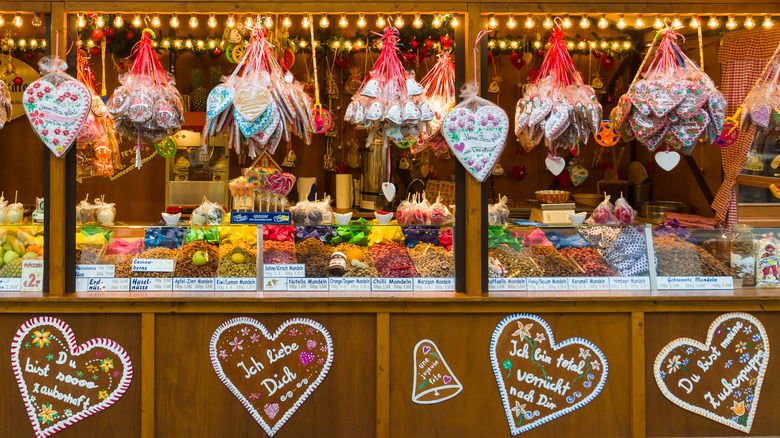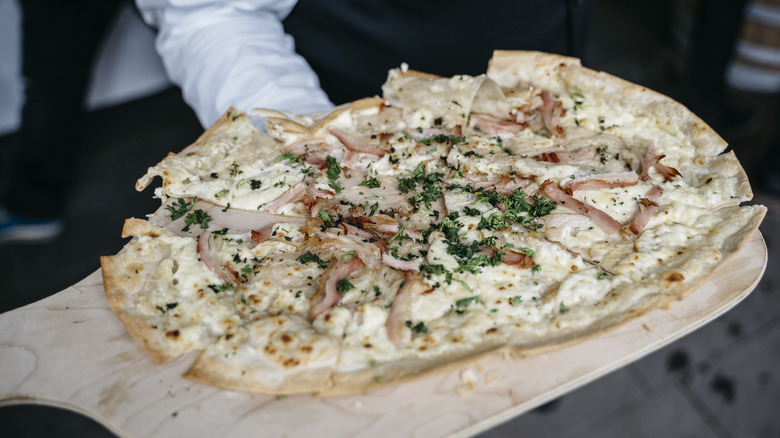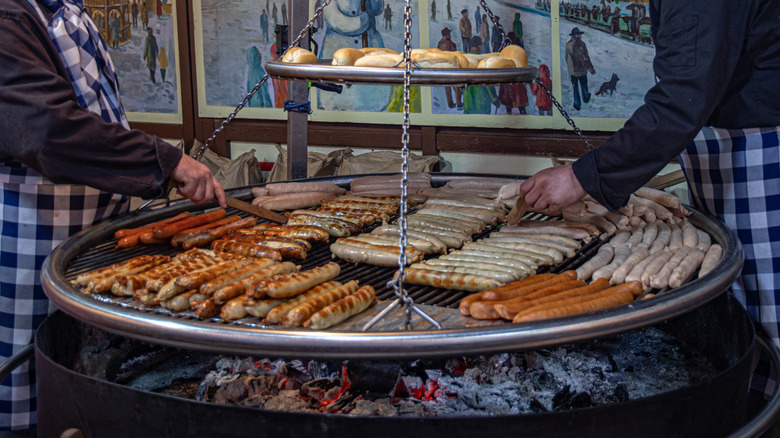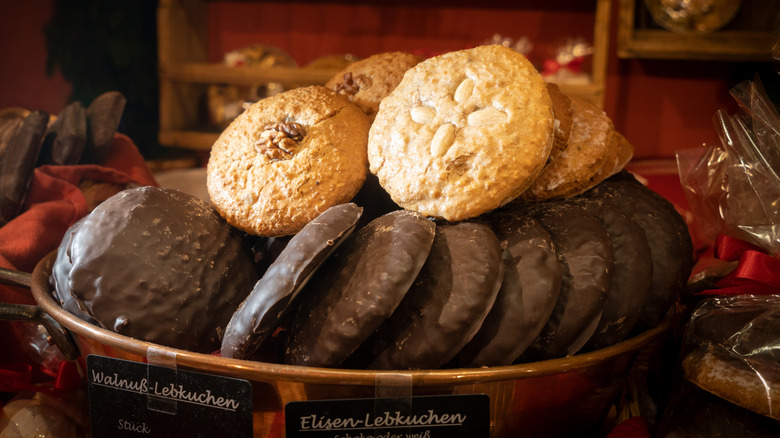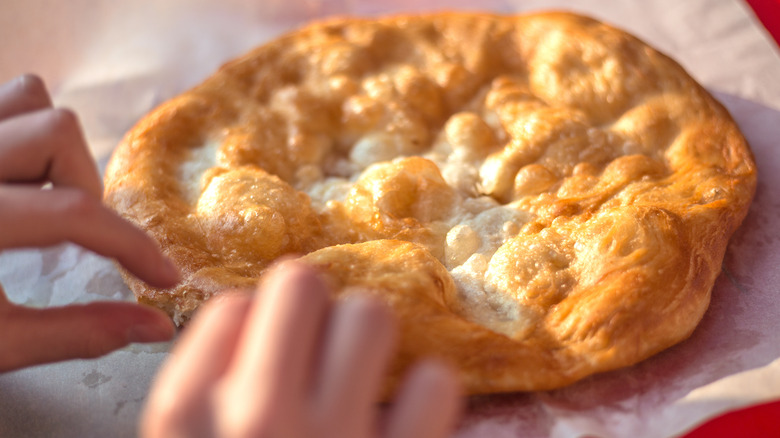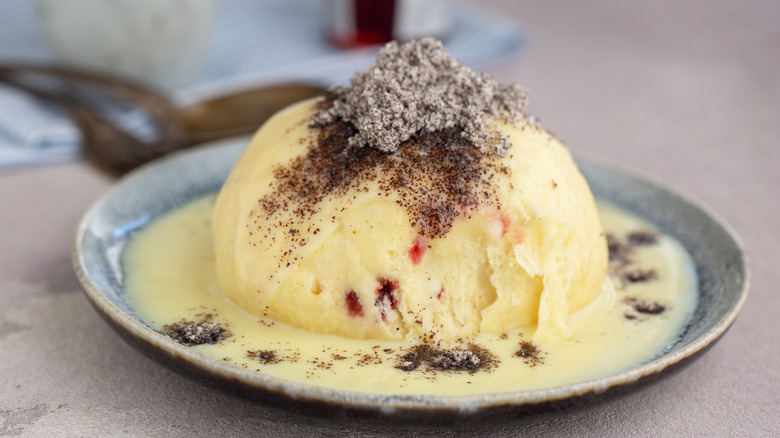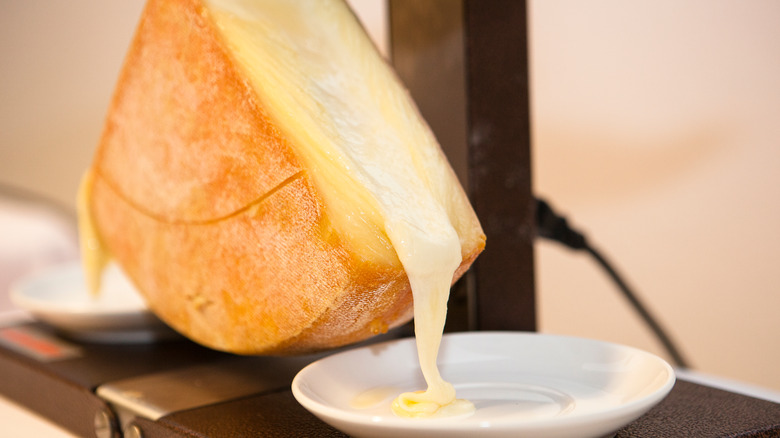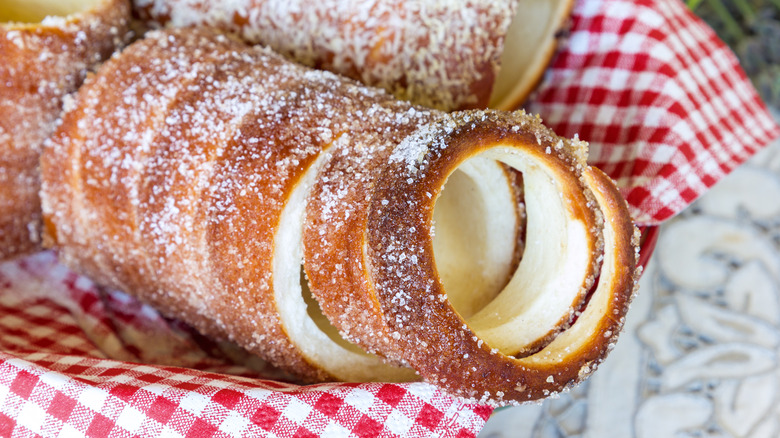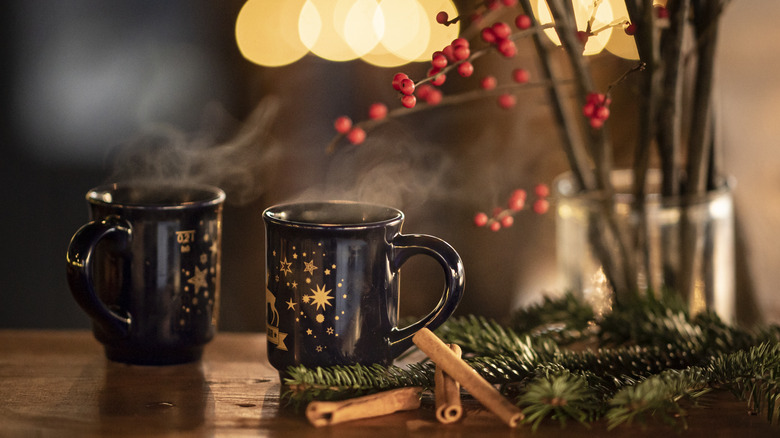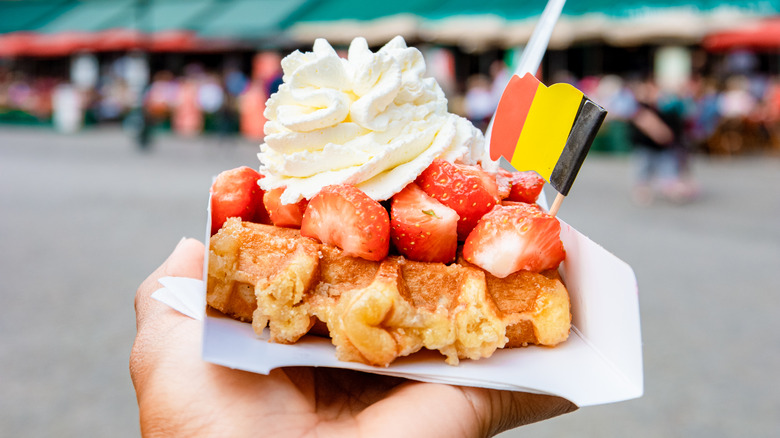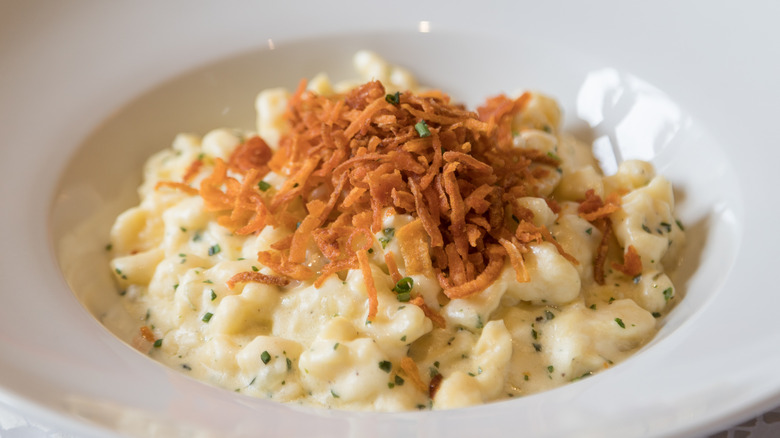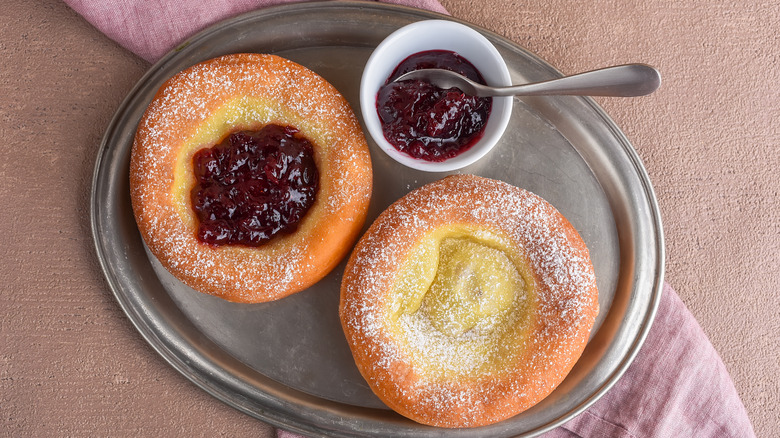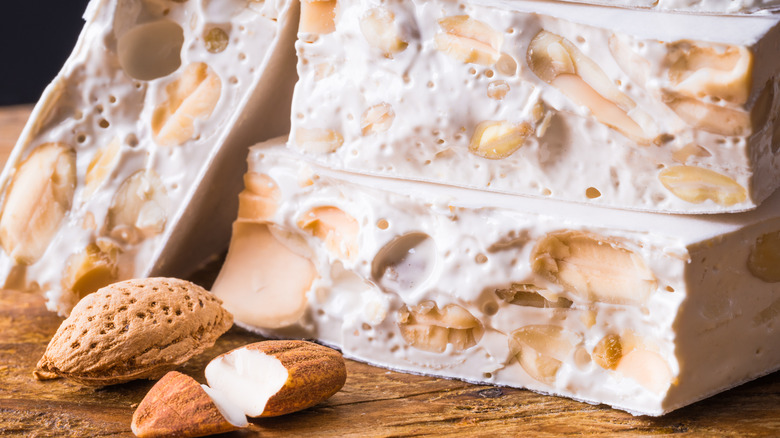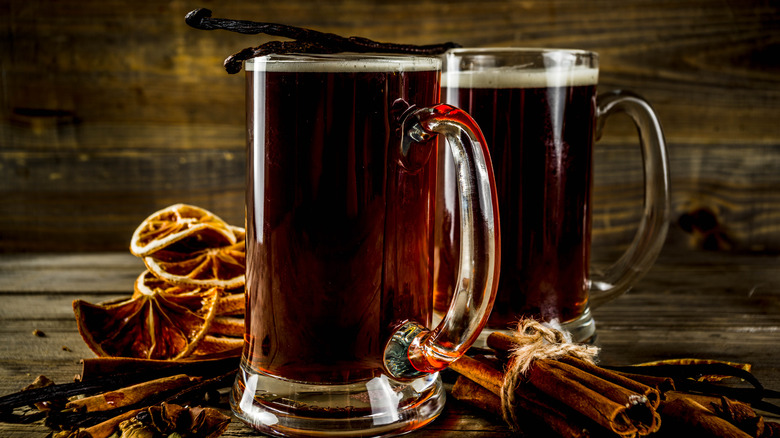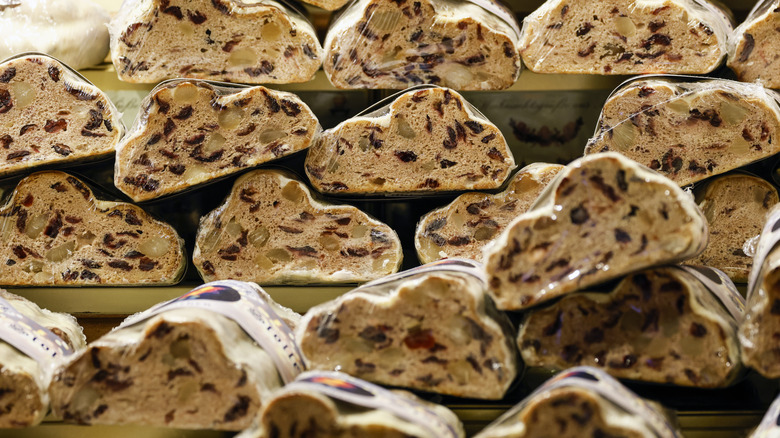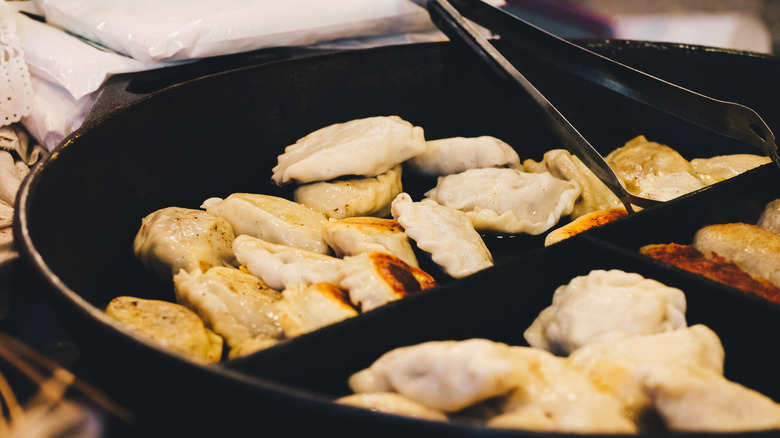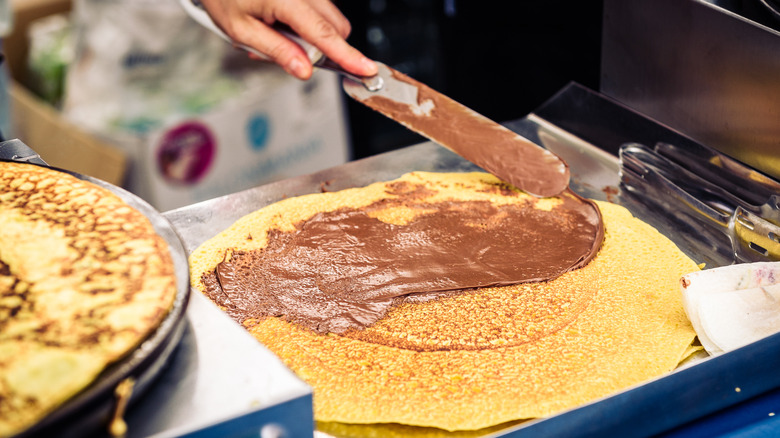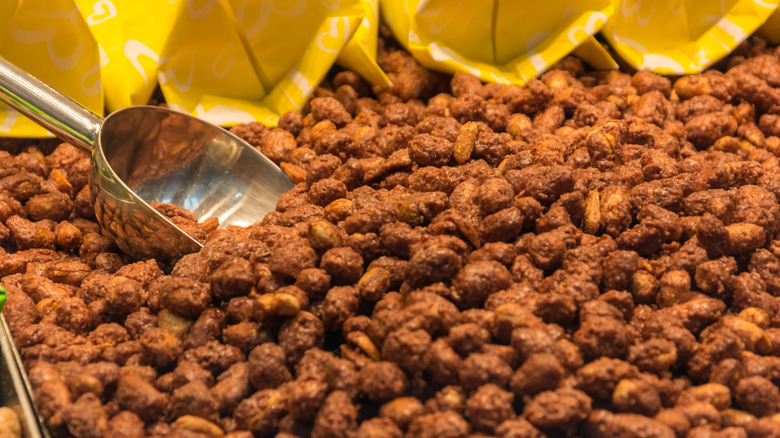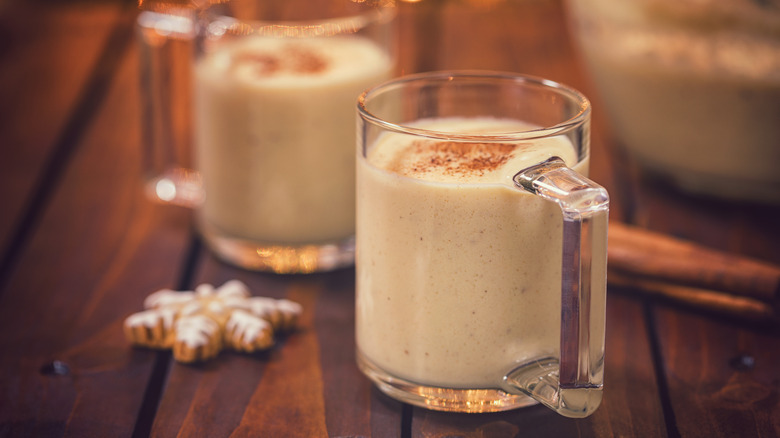Christmas Market Foods You Need To Try At Least Once
Christmas fairs are central gathering places where food and drinks are shared in a festive atmosphere teeming with sweet anticipation of our favorite holiday. Local markets are decorated and dotted with colorful stalls selling trinkets, nibbles, and copious amounts of mulled wine. The air is filled with warming and smoky aromas, and the atmosphere is brimming with comfort and joy.
This festive tradition started in Germany, which is still considered the leading destination when it comes to Christmas markets. According to Heritage Journal, Germany hosts 2,500 to 3,000 Christmas markets annually. Unsurprisingly, most food at Christmas fairs is inspired by German tradition, but as the markets evolve, the offer incorporates many European specialties, internationally-inspired dishes, and many local delicacies deemed worthy of being included in the nicest Christmas tradition.
As the list of dishes and drinks at Christmas markets is extensive, the following roundup includes the best and most reliable choices. These dishes, snacks, and sweets are easily portable, convenient, warm, and simply wonderful. You still have time to visit the Christmas market nearest to you, but there is no time to hesitate; get there as soon as possible, nibble on some of these market classics, and let the festive atmosphere set you in the mood for Christmas.
Flammkuchen
Alsace is a unique French region. As it's located right next to Germany, Alsace is filled with dishes with unquestionable German influence. Even the names of these dishes often reflect this unusual neighboring synergy. Such is the case with tarte flambée or Flammkuchen. This is one of the best-known dishes from Alsace, and despite its German-inspired name, it has a clear French origin. Flammkuchen is made with bread dough that is thinly rolled to get a distinctive oval shape. Traditionally, this Alsace specialty is smeared with crème fraîche and topped with sliced onion and fried bacon. It is often compared with pizza, but the resemblance is only in appearance (via Mon Panier Latin).
You will find the dish at many French and German Christmas markets. It is one of our favorites because of the hearty, winter-like toppings and the convenience. You can easily nibble on a slice of Flammkuchen while you explore other Christmas market treats. Apart from standard Flammkuchen garnishes, the toppings sometimes include mushrooms or generous amounts of grated cheese. The dish is usually sprinkled with freshly chopped herbs when it's served for that extra kick of freshness.
German wurst
Sausage is king in Germany. Also known as "wurst," sausages take central stage in German cuisine, and the country boasts a surprising number of varieties; Michelin Guide mentions almost 1,200 different categories. Though they are usually not restricted to seasons, winter is the ideal time to indulge in a crisp bratwurst or flavorful German-style blood sausage. Of course, there is no better place to enjoy it than a colorful Christmas market. Of all the things on this list, sausages are almost universal to all Christmas markets, in or outside Europe. German-style sausages will either come tucked inside the buns or served with bread rolls or pretzels, mustard, and sauerkraut on the side. Currywurst is perhaps one of the most unusual varieties. As Michelin Guide explains, this bratwurst is cooked, fried, smothered in a sweet and spicy sauce, and served dusted with curry powder.
Of course, there are many techniques for cooking sausages, but the common German practice is to use a traditional "schwenker," in which the grill is suspended over burning coals. The unusual technique prevents the sausages from burning and imparts the perfect amount of char and smoke (via German Girl in America).
Lebkuchen
Nothing says Christmas more than aromatic and spicy cookies. This version from Germany is often translated as gingerbread, but unlike crisp and thin gingerbread cookies, Lebkuchen are soft, dense, and usually on the thicker side. They are brimming with baking spices, namely cinnamon, nutmeg, cloves, and cardamom, and have a strong honey-like aroma and flavor. Among the numerous varieties, the nut-packed Nürnberger Lebkuchen, which many consider the original, stands out as the best and most popular. The somewhat basic Lebkuchen version often incorporates only wheat flour and honey.
These days Lebkuchen come in various shapes and sizes. You will find intricately decorated, heart-shaped versions, those filled with jams or marzipan, and even some packed with candied fruit; all of them regularly appear at Christmas markets around the world. The chewy, spicy cookies are the best sweet snacks after a hearty market fare and make a perfect accompaniment to mulled wine. As they keep well, you can take one as a souvenir (via Leckerlee).
Roasted chestnuts
Chestnuts are traditional treats in several Mediterranean countries, China, and the U.S. Though their popularity slightly diminished in the last couple of decades, they are still considered an important addition to any festive season. Roasting chestnuts is a common sight at the beginning of the fall, but as their season extends to winter, they often appear at Christmas fairs. The vendors will roast them over open flames, letting the shell loosen and allowing the nuts to get a slight char. The warm, aromatic package of roasted chestnuts perfectly fits the description of a cozy Christmas market atmosphere, and nibbling on a warm chestnut is one of those delightful moments you should experience at least once in your life (via Foodal).
Just like other nuts, chestnuts will also develop flavor when they are roasted. The slightly bitter taste of raw chestnut will turn into creaminess and subtle sweetness, and the flesh will become tender and crumbly. The aroma of roasted chestnut might be the best part, as it results in a wonderful mélange of smoke and nuttiness. Roasted chestnuts will ideally work with any hot Christmas cocktail.
Lángos
Along with the spicy goulash and delectable layered cakes, one of Hungary's most successful food exports is undoubtedly the humble lángos, a traditional treat best described as a round disc of deep-fried dough. Lángos delights with its chewy texture, incredibly crispy edges, and almost pillowy, tender center. If this doesn't sound tempting enough, this piece of fried dough is usually smeared with various toppings; some favorites are sour cream, garlic, and cheese.
Hungary Today explains that lángos is not only reserved for Christmas. In its native country, you can see lángos stalls all year round. The fat-laden deep-fried dough is not deemed too heavy even for hot summer months. Apart from savory fillings, you can find lángos garnished with sweet toppings. The most common sweet options include fruit jams and chocolate spreads. Whether you like it sweet or savory, make sure not to skip the stalls with stacks of deep-fried lángos at your local Christmas market. What's better than a crisp piece of deep-fried dough on a chilly winter day? A bonus is that you can easily share it, but we're not sure you'd want to.
Germknödel
Germknödel is a stunner. If you ever see it at a Christmas market stall, you will hardly resist the urge to dig into this soft, feather-light dumpling. Germknödel originated in Vienna, according to Wien Info. It consists of a tender dough that hides spiced plum jam in the center. When steamed, the bun is served doused in butter. A sprinkle of poppy seeds adds a final touch that makes this hefty dumpling look like it's imitating snow-capped mountain peaks.
Germknödel was initially served at famous ski huts in Austria, but it soon outgrew its original ambition and even crossed the border to become one of the most delectable treats at Christmas markets. However, it only shows up during the colder winter season. Apart from butter, you will also see it doused in a rich vanilla-flavored sauce. One thing to remember is that traditional treat usually acts as the main course, but regardless of how you classify it, Germknödel will be something that you will be dreaming of until the next Christmas season comes (via Parts Unknown).
Raclette
Any form of melted cheese is glorious, but there is nothing better than having Swiss cheese melted directly onto your plate. As explained by Switzerland Travel, the term raclette can either refer to a type of cow's cheese or to the dish in which this cheese is melted and scraped — the name stems from the French word racler, meaning to scrape — onto your plate. At Christmas markets and restaurants, you will see a large block of raclette cheese placed under a broiler that will evenly heat the side of the cheese wheel. As the top layer melts, it is gently scraped down into portions. Ideally, you will have the cheese melted over an open fire, so it attains all those rich smoky notes.
Of course, you don't eat all this gooey cheese on its own; you need nice accompaniments to go with it. Traditionally, you will have pickled onion bulbs, crisp cornichons, or bite-size pieces of boiled potatoes. After reading this, we are sure you will go for this traditional Swiss Christmas Eve cheese if you see it in one of the stalls. Even if you don't, there is a slim chance you will miss a big block of it melting under a broiler.
Chimney cake
Kürtőskalács earned its descriptive nickname due to the unusual, conical shape reminiscent of a chimney. This traditional European street snack dates back to the 18th century and traces its roots back to Transylvania, a Romanian region that was once under Hungarian rule. That's why you often see disputes over its history and origin. Nowadays, this delicious treat is not limited by borders and has gained quite an international following. It's not a strictly seasonal product, but you will often find it sold during winter, and of course, it's a staple dessert at Christmas markets as it's pretty convenient to eat on the go (via Atlas Obscura).
It is made with a thinly rolled dough sliced into a strip that is neatly wrapped around a thick metal or wooden skewer and is then gently grilled over fire. As it bakes, it is sprinkled with sugar, and as you would expect, beautiful things begin to happen. The sugar caramelizes, the pastry attains a wonderful golden color, and it gently puffs up. Finally, these hefty cakes are usually sprinkled with flavorings and garnishes. Cinnamon sugar is the traditional option, but modern iterations step away from the humble cinnamon-dusted chimney cakes, and now you will see decadent cream or chocolate-filled versions that are lavishly garnished (via Kurtos Kalacs).
Mulled wine
Mulled wine is the ultimate Christmas market drink. This warm, spiced mug of wine is almost synonymous with the Christmas season, and the markets are usually packed with mulled wine stands that serve this spice-laden drink. The warmth of the wine and the intensity of baking spices create a perfect blend of flavors and aromas. Mulled wine is quite versatile, and as Expat Explore explains, you will find different regional versions of mulled wine — under various local names — but they would all fill your soul with festive joy. Vendors can sometimes add a shot of boozy spirits, and we strongly encourage you to choose this superior, alcohol-laced version.
Apart from the classic mug of mulled wine, you may come across a version best described as mulled wine on steroids. As explained on Atlas Obscura, feuerzangenbowle is a fiery version that starts as mulled wine but comes served with a sugar loaf (zuckerhut) that is doused in rum and set on fire. The drink is quite a visual spectacle, but the rum and sugar that slowly drip into the mug also provide flavor and complexity.
Waffles
Waffles have long gained international popularity, but they are still strongly linked with Belgium as the place where they originated. Although they are found all year round, waffles are a staple at Christmas markets in their native country and around the world. Deservedly so, as they are convenient, portable, and utterly delicious. Though you've certainly had a waffle before, you might not know that there are two traditional waffle styles. Ampi explains that the thick waffle comes from Liège, while the slightly lighter and softer version is typically associated with Brussels.
Regardless of subtle differences, both varieties are stamped with a checkered pattern and those tiny pockets that hold all those juicy toppings. Ideally, your Christmas market waffle will be warm and fresh. If a plain version is your thing, who are we to judge? However, if you like decadence, you can choose from a decent number of toppings; some favorites are chocolate, whipped cream, and fresh fruit. Don't worry about going overboard. Christmas is not a time to skimp and count calories, especially at a festive winter fair.
Käsespätzle
Think of käsespätzle as the superior version of mac and cheese. Despite the tongue-twisting name, this dish is relatively straightforward and comes packed with flavor and gooey cheese, so basically, everything you want to eat at a Christmas market. This German classic is a combination of pasta and cheese traditionally made with fresh egg noodles, locally known as spätzle. Masterclass explains that these soft noodles originate from the historical Swabia region, and they describe them as ununiform and wrinkly but perfect for holding all the pasta sauce. In this case, the hefty amount of melted cheese nicely coats pasta strands and fills all the creases.
Curious Cuisinière clarifies that the dish typically incorporates alpine cheese, such as Emmentaler or similar milky and flavor-packed Swiss-style cheese varieties. It suggests caramelized onions as the ideal topping, while Masterclass claims that a heap of crispy fried onions is the traditional way to serve this comforting classic. Either way, you will get a perfect wintertime dish.
Kiachl
Innsbruck is the capital of Tyrol, a mountainous Austrian region known for hearty and nutritiously rich local fare. Kiachl, a deep-fried specialty that falls somewhere between bread and a pastry, is a local delicacy that perfectly fits the description. As explained on the official Innsbruck website, kiachl is made with leavened dough that is deep-fried until crisp. It was traditionally served as an accompaniment with main courses, but it also works as a savory snack topped with pungent sauerkraut or as a sweet treat smeared with a thick layer of fruit jams.
Kiachl has come a long way from its humble beginning. Though it was once often shunned and replaced with more filling market options, kiachl has come back with a bang. These days it is rarely made at home, so Christmas markets are a perfect opportunity to get a fresh, crisp kiachl — served with a hint of nostalgia and a healthy dose of tradition.
Turrón
Turrón is not only reserved for Christmas markets. As soon as the festive season approaches, you will see this Spanish-style nougat and its countless varieties popping everywhere. As explained on The Local, in its simplest form, turrón typically consists of eggs, sweeteners, and toasted nuts — almonds being the ultimate favorite. It can either come in a hard, brittle-like version (Alicante) or as the soft, pillowy turrón that will instantly melt in your mouth (Jijona).
This traditional Christmas treat originally made its way to Spain during Arab rule, but it is now deeply ingrained in Spanish culinary heritage. It's even one of the favorite sweets among Spanish royals. This traditional treat sometimes comes with a high price tag, but when stored properly, it can have a relatively long shelf life. We recommend taking one home to recreate the festive Christmas atmosphere in a home setting.
Mulled beer
We're confident you've had mulled wine or mulled cider at least once in your life, but have you ever seen, heard, or tasted the wild concoction that goes under mulled beer? It isn't as crazy as it sounds. Essentially, mulled beer is merely heated beer with added mulling spices. It will typically include a sweetener; honey could work well for this version (skipping honey can also be one of the mistakes you make with mulled wine), and some classic spices such as cinnamon and star anise. Typically, some malt-forward styles will be used for making mulled beer, as light or hoppy lagers don't have enough body and character to match the intensity of spices.
If wine is not your thing, and you'd rather reach for even a mediocre IPA, mulled beer might be an ideal Christmas sipper. It is also an excellent option for the adventurous who get tired of the sometimes syrupy and overly sweet character of classic mulled wine.
Bonus: local spirits
Though mulled wine is the ultimate drink at most Christmas markets, you shouldn't skip all the local spirits that will keep you warm and amp up that festive atmosphere. One of the most common spirits is jenever, a spirit best described as a predecessor and inspiration for the juniper-flavored gin. As Difford's Guide explains, jenever is native to the Netherlands and Belgium, where you will usually find it at local Christmas markets. Juniper is one of the main flavorings in jenever, but it won't be as dominant as in classic London dry. With a richer malt-wine base, this local drink is an ideal sipper for the winter season. Don't miss the fruity, flavored jenever versions.
To get some of that traditional Scandinavian atmosphere, seek out aquavit. This strong spirit is usually flavored with caraway or dill, and it will be a perfect match with heartier Christmas fare (via Scandinavian Standard). Of course, many markets will also feature potent German-style fruit brandies.
Stollen
Stollen is a wonderfully fragrant bread that pops up around Christmastime. Packed with a medley of citrusy aromas, this spiced bread is usually laced with rum or brandy and dotted with various dry fruits. Despite being a yeasted bread, it is compact but comes off as incredibly buttery and has a distinctive melt-in-your-mouth quality. Traditionally shaped in a loaf — that is said to represent baby Jesus — the bread is smothered in butter and covered in powdered sugar.
The origin of stollen is intricately related to Dresden, where it first appeared in the Middle Ages. This local version has been officially protected as a valuable gastronomic heritage and can be found all year round, but stollen is made and enjoyed across the country. You will find it at most Christmas markets in Germany or its international adaptations.
Stollen is not too sweet and is the perfect Christmas bread to pair with a hot drink. At Christmas markets, it finds ideal partners in mulled wine or spiced punch. As it has a relatively long shelf life and transports easily, it is an excellent market treat to take home as a souvenir or a thoughtful gift. You can serve it with butter and fruit spreads, or even turn it into comforting bread pudding.
Pierogi
The next Christmas food on the list is the epitome of comfort. Pierogi are half-moon-shaped pockets of dough that are packed with hearty fillings. Typical ingredients that you will find nestled inside include meat, potatoes, cheese, mushrooms, and even sauerkraut. The fillings are used individually, but different combinations are also common. Sometimes these dumplings come in a sweet version, mainly with a fruit-based filler. Pierogi are boiled and usually have a tender, pillowy texture, but they also work well as a pan-fried version when they attain a crispy, golden crust.
Pierogi are a classic, traditional dish and one of the most popular Polish specialties. They are a year-round option but also one of Christmas staples. Usually, Polish families make meat-free versions on Christmas Eve, but these hearty parcels also find their place in Christmas markets.
Pierogi are an excellent market food and an ideal snacking option, as they are portable and easy to munch on the go. Whether you take boiled or fried versions, pierogi will come warm, providing a comforting, cozy hug for your tastebuds. One portion will keep you happy and satisfied, but you will have room to pack other market delights. Pierogi can come as is, but sometimes, they will come dressed up with crispy fried bacon.
Crêpes
Crêpes do not need much introduction or elaborate explanation. These thin pancakes are one of the legendary dishes of traditional French cuisine and have long found their home in other regions and countries. Though they are not reserved for holidays or special occasions, you will commonly find them at European Christmas markets.
They are usually prepared on specialized, flat pans, resulting in a thin pancake that will attain a crisp crust on the edges but retain that tender, chewy texture in the center. The most beautiful thing about these pancakes is the seemingly endless possibilities to dress them up. Savory versions are pretty standard, but crêpes are the perfect blank canvas to play with sweet additions. Anything works here; a sprinkle of sugar, cinnamon, chocolate spreads, caramel, fruit, jams, pastry creams, crushed cookies, and even ice cream makes a beautiful pancake filling. A sprinkle of powdered sugar and a drizzle of chocolate sauce on the top are the perfect finishing touches.
When rolled or wrapped up, crêpes become easily portable, which makes them convenient for Christmas markets as you mostly eat standing up or on the go. These versatile pancakes are great when you're craving a quick snack or a dessert, and the biggest problem will be to choose your favorite filling.
Roasted almonds
While walking around a typical European Christmas market, it's inevitable to get lured by a lingering sweet-inducing whiff reminiscent of caramel and sugar. This scent is so distinctive and potent that you might immediately think it comes from an elaborate Christmas treat, and you will probably be surprised to find out that this tantalizing aroma most likely comes from candied roasted almonds.
This seemingly simple Christmas delicacy pairs almonds with sugar and spices to assemble a sweet, crunchy snack. The process allows the sugar to caramelize and crystallize, creating a thick, sugary coating unevenly encased around each nut. The choice of spices can vary, but cinnamon is a firm favorite, and though some other nuts can be added to the mix, almonds are the most traditional choice. Your order will probably come packed in a paper cone, making it easy to hold and snack on while browsing for other Christmas delights and enjoying the festive atmosphere.
Candied roasted almonds are usually associated with German markets, but luckily, they did not keep this treasure for themselves, and you'll easily find these sugary nuts at various Christmas fairs. They are also sold as a street snack that starts appearing as soon as cold weather hits. As they can keep well, you can always get extra pouches to enjoy when you get nostalgic about the Christmas season.
Egg punch
Though mulled wine is the official drink at Christmas markets, don't miss its creamier and sweeter counterpart, usually labeled as egg punch or Eierpunsch. Similar to eggnog, this velvety drink combines egg yolks with a fragrant blend of white wine and spices, resulting in a frothy, silky-smooth combination brimming with warming aromas.
The recipes vary, but vanilla, clove, nutmeg, and cinnamon are usually the dominant aromas. Citrus juice is commonly added for a touch of brightness and zest. In line with Christmas tradition, egg punch is heated as it should be sipped while it's warm. It will usually come served with a generous heap of whipped cream, finished with a whiff of cinnamon. Think of egg punch as the more indulgent Christmas drink, decadent enough for those moments that call for extra warmth and joy.
Egg punch is unquestionably a must-try, but there is a slightly different and equally delicious alternative that you will see labeled as Eierlikör. This version shares more similarities to Dutch Advocaat. It is somewhat more potent as it uses brandy or rum as the base, but it shows a similar character packed with vanilla-like notes and an incredibly creamy palate.
